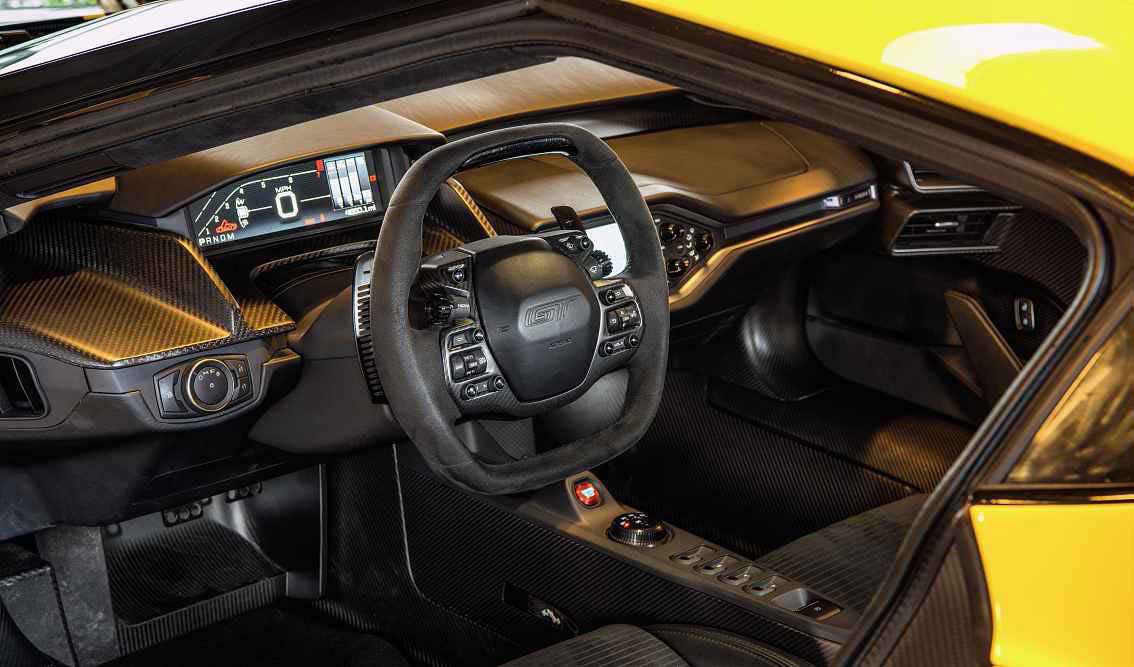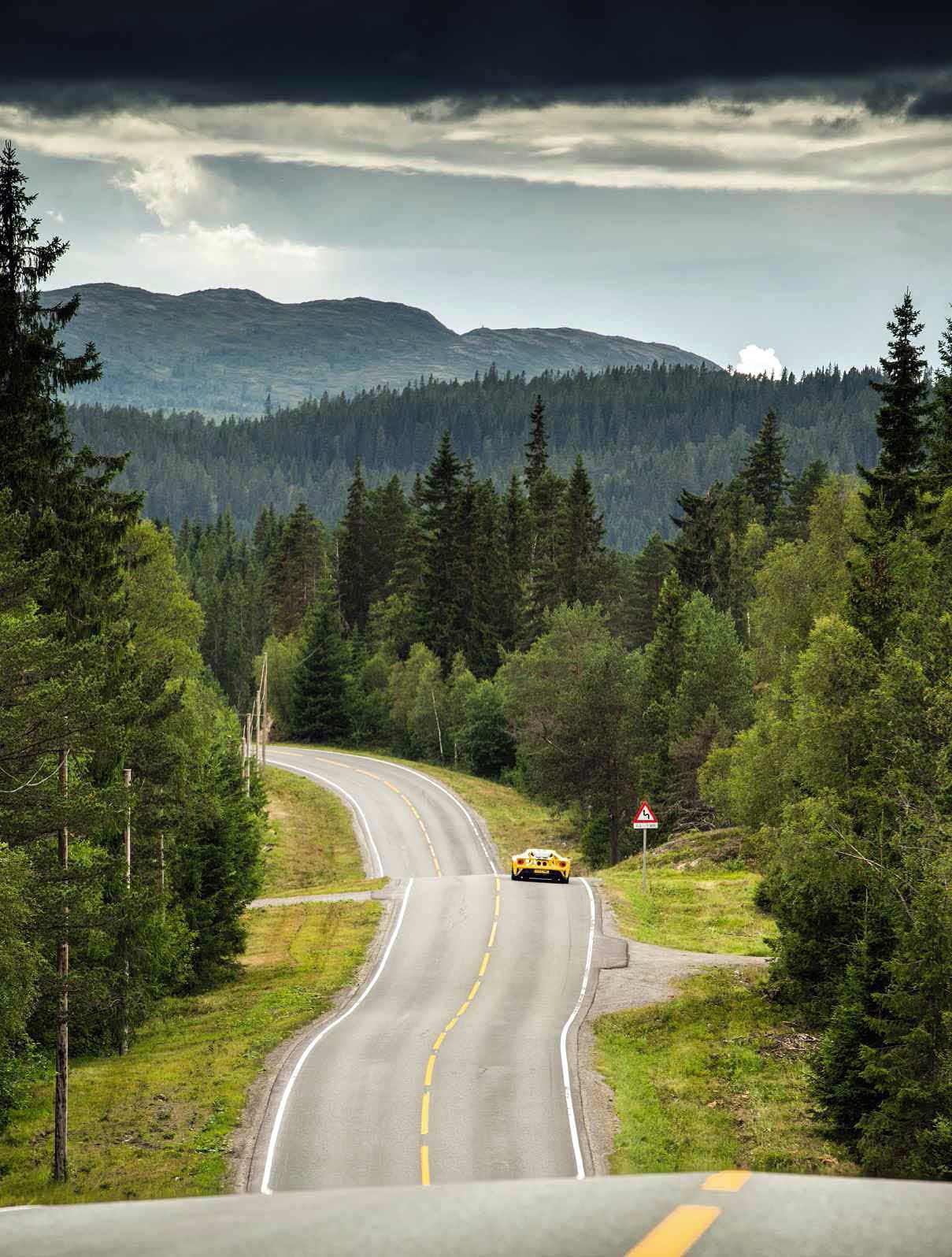
Ford GT to the arctic. There are closer racetracks, there are faster roads, but it’s not every day you get asked to take a new 2018 Ford GT to the Arctic Circle Raceway to set a new lap record. Fjord GT. So far the latest Ford GT has seemed too hardcore for its own good. Can a week-long road-trip through stunning Norway, and the chance to set a lap record at the Arctic Circle Raceway, convince us otherwise? Words by Steve Sutcliffe. Photography by Aston Parrott.
Sometimes stuff just works. Sometimes. Ideas get presented, plans get made; hotels, flights and hire cars get booked. But all too often they later get un-booked. And sometimes re-booked but for a different day. And then every once in a blue moon it all turns out to be just fine. It all turns out to be just right. Which is what happened pretty much all the way down the line when we took a bright yellow Ford GT to Norway.

First of all we went to the Atlantic Ocean Road near Molde, which, as you can see, was a reasonably mind-altering experience in itself. But then we drove the GT 500 miles north via Trondheim and the extraordinary E39 and E6, all the way up to the town of Mo i Rana and beyond. Right up to the Arctic Circle Raceway, the northernmost racetrack in the world. The original idea was nothing if not simple. Take the GT to arguably the most beautiful road in unarguably one of the most beautiful countries on Earth. Drive it there for a couple of days and, of course, film and photograph it there from every which angle. And then head north, all the way up through half of Norway and, once there, try to break the road car lap record for the Arctic Circle Raceway, held by an Audi R8.

In total it would take us just over a week to complete our mission, but the planning had begun many months earlier. The journey from ‘our’ GT’s temporary home in Essex to Molde in Norway is an absolute monster in itself – some 1400 miles across seven different countries – and because there are just two GTs in Europe at the moment (both of which are looked after by Ford GB), Ford, quite understandably, didn’t want us to put that much mileage on the car merely by driving it to and from the location.
‘It’s a surreal piece of road on which the GT looks – and just is – out of this world’
So a truck was organised to deliver it there: a very big truck that also happened to contain lots of spare tyres, one or two spare parts, a Focus ST Estate camera car and an awful lot of camera equipment. Which also meant that something called a carnet form had to be completed, detailing every last nut and bolt of the truck’s cargo, including serial numbers for every single item. So as you can imagine, the planning of this element alone took us weeks to get right. And once we join the Norwegians and come out of Europe, finally, it will be exactly the same pantomime each and every time we travel abroad with professional camera equipment. So we’ve got that to look forward to post-Brexit, cheers…

In the here and now, however, what’s equally clear is that the average Norwegian goes absolutely crackers for the Ford GT, because even as the truck was unloading in an otherwise deserted car park in the coastal town of Kristiansund – which sits at one end of ‘The 64’ Atlantic Road – a decent crowd had already begun to form. By the time the GT was actually off the truck and parked up, ticking over loudly, as it does, a sea of smiling faces was snapping the car from all angles on all sorts of phones. And ten minutes after that the entire staff from the local Ford garage had turned up, including the boss, all with their heads shaking and their eyes bulging in bewilderment.
I had to pinch myself for a second when, finally, I stood back and realised that we’d actually put this thing together; that we’d made it to the location without any major issues, and that for the next week it would be all about driving the Ford GT. And not just driving it but also living with it, looking at it, photographing it, filming it, listening to it, watching other people go completely berserk for it.
And at the end of that week we’d know all about the Ford GT. Not merely how quick it is or how lovely it is just to look at, but also how good it is as a supercar, full stop. And by the end of it all we could surely, genuinely, decide if a) the new Ford GT actually warrants its circa-£335,000 price tag or not, and b) whether it deserves a place among the true greats.

First stop, the Atlantic Road itself. Completed in 1989 at a cost of some 120million Norwegian krone (around £11.5million), its 5.2 miles cross a series of archipelago islands to link the villages of Karvag and Vevang. It’s a surreal piece of road that’s won numerous design awards over the years, rightfully so, and on which the GT looks – and just is – out of this world.
To be honest, though, the Atlantic Road is not the best place to get properly beneath the skin of a Ford GT, even if the surroundings are entirely spectacular. And the problem ultimately is the speed limit. And the traffic. What happens when you reach the Atlantic Road is this: You take one good look at it and think, right, here we go, what a road, what a place. And then you see a sign telling you the speed limit is 70kph, which rises to the heady heights of 80kph in the evening, when there are one or two fewer camper vans around driving backwards and forwards along the road.
So in a Ford GT with 647bhp you quite quickly begin to wonder what all the fuss is about over the Atlantic Road. You soon want to be somewhere else. But the circumstances do force you into thinking about the car in a different kind of light, at a different speed, one that’s considerably lower than you’d naturally like to do in a 216mph mid-engined car that was essentially designed to win at Le Mans.

At a heavily enforced 45-50mph, for example, you have lots of time to drink in the more fundamental aspects of the GT, such as its cabin design, its dashboard layout, its driving position and its basic mechanical refinement, none of which is especially brilliant.
Actually that’s not true, the driving position itself is peachy once you’ve managed to climb in and hunker down into the seat. But the problem is, the seat doesn’t move because it is part of the carbonfibre tub. So instead you have to heave on a piece of cable down in the foot-well, at which point the entire pedal box is released, and then moves. You then need to either hook your feet beneath the assembly to pull the pedals up towards you or push them away to get them just where you want them. Which to be honest is a right old palaver compared with a seat that moves back and forth.
Once you’re in and have got the pedals where you want them, however, the GT feels great; it feels like a proper, bona fide mid-engined supercar. Even if its instruments, steering wheel and cabin materials are the wrong side of ordinary for a car that costs around £335,000. It sounds good, though. Boy does it sound good. It sounds awesome actually, and that’s surely more important than a cabin that wants for a bit of design flair and which is strangely lacking in the usual exotic materials.
The noise the GT makes at low-ish speeds is deeply intense, quite Neanderthal in its appeal in some ways, and maybe even a bit OTT compared with some rivals. The car as a whole sounds incredibly busy, even down at 40mph, with stones pinging into the wheel-arches and a fair old bit of road roar from those massive 325-section 20-inch rear Michelin Pilot Sport Cup 2 tyres. The engine and its exhaust are also always audible, even when you’re just pottering about at 2000rpm in top gear. Yet in a way this is what defines the Ford GT as the car that it is; as the racing car for the road that Ford might not want us to think it is but which, in fact, it absolutely is.

After a week in it, I’ll actually begin to go full circle about this particular aspect of the GT. I’ll end up thinking that this might be the way to go with cars such as this. Because let’s face it, you don’t drive/own/buy a car like the Ford GT – or a 918 or a P1, etc – wanting everyday Mondeo-style refinement from it. You drive a car like the Ford GT to make your heart, mind and imagination go to another place, and I think the fact that you need to suffer a bit in the process with regards to refinement, noise, comfort, whatever, actually heightens the overall experience in a weird kind of way – so long as the thing delivers where and when it matters most.
And holy smoke does the Ford GT deliver where it matters most.
Once we’re all done on the Atlantic Road we pack up and aim the GT and our various support vehicles north, towards the town of Trondheim on the E39, and that’s when the GT begins to show its teeth, mainly because there is so much less traffic around. For the first few miles, though, not much happens on the E39, except for a ferry that needs to be boarded between Halsa and Kanestraum, providing another opportunity for the people of Norway to go nuts for the Ford GT – to a point where the guy who is supposed to take the toll money actually refuses to accept any payment because we are driving ‘the Yellow Car. The one that’s in the local newspaper today.’
According to someone else on the ferry we’ve been talked about on the local radio station this morning as well. Norwegians, it seems, are rather fond of the Ford GT, and as the traffic becomes thinner on the other side of the ferry and the E39 gets into its stride – in places it is an astonishing piece of road – the Ford GT starts to like Norway.
But that’s nothing compared with what unfolds 90 miles later, on the far side of Trondheim, where the E39 disappears and is replaced by the E6. For the first 20 miles or so this road isn’t up to much, but the further north you go on it, the madder it gets. And it goes on for literally hundreds and hundreds of miles, spearing through some of the most hauntingly beautiful countryside you will ever see.

And in a bright yellow supercar – hypercar? – it is pretty much impossible not to get carried away from time to time on the E6, despite the seemingly draconian speed limits, because the road itself is so fantastic, but also because, well, there’s quite often no one else around. You sometimes don’t see another car for 15, 20 minutes. So how can you resist the temptation?
And that’s when the GT goes to another place. Technically you’re not supposed to drive it in Track mode on the road at all, something to do with pedestrian protection laws or some such because the ride height drops by a chunk and a big wing automatically rises out of the tail. But when there’s no one else around, who cares? The car looks utterly incredible with the wing out, and it drives that much sharper as well because the gearbox and throttle maps get snappier while the suspension firms up, too. Not that the GT feels in any way turgid in any of its regular modes, even if the ride comfort becomes a touch smoother and less noisy in the Normal setting.
But that’s the thing about the GT. Even in Normal it’s still noisy and unrefined and uncompromising compared with something like a McLaren 720S or a Ferrari 488, so you might as well drive it in full nuts mode all the time. And in full nuts mode it is tiring and loud and has almost no ride refinement whatsoever on the public road, but it is also a quite fantastically exciting car to drive. It even has some good old-fashioned turbo lag because the boost pressure, as you can imagine, is quite high in order to squeeze 647bhp and 550lb ft out of a 3.5-litre V6. It’s one of those cars in which every millimetre of throttle travel makes a difference, incites a slightly stronger reaction from what lies beneath the rear bodywork.
A small squeeze on the accelerator pedal still incurs an almighty cacophony of whooshes and whistles from behind you, but not necessarily a huge level of thrust, not yet. Press a bit harder though and – bang! – there is it, a massive hit of energy that compresses you back in the seat, and makes you grip the not especially lovely looking steering wheel that little bit harder. And still you haven’t yet got anywhere near full throttle.
When you do, the GT feels and sounds and just is ever so slightly mental. Officially the 0-60mph claim is ‘under three seconds’, but unofficially it’s 2.8sec, which if you really stop and think about it is borderline insane for a rear-wheel- drive road car. Yet the most shocking aspect of its performance is that it actually feels, and sounds, considerably quicker between, say, 50 and 120mph than it does when going from 0 to 60. The way its torque builds so fast in the mid-range and just explodes into the rear tyres beyond 3000rpm is pretty rude. And the seven-speed twin-clutch gearbox works quite nicely, too, even if it doesn’t have quite the same snap of response as the very best dual-clutchers from Ferrari, McLaren, et al.

Like I say, it’s easy to get completely carried away in a Ford GT, on a mostly deserted road, among some of the most breathtaking scenery you’ll ever come across, anywhere. But… we have one last piece of the jigsaw left to complete our week-long tour of Norway in the GT, and that is to try to break the lap record at the Arctic Circle Raceway. And to do that we have enlisted the services of one Stefan Mücke, who normally drives his GT at Le Mans.
When we get to the raceway the sun is shining and the paddock is chock full of racing bikes, whose owners and riders are more than a little bit interested in the GT. Once again the car takes centre stage, and when I go out in it later for a bit of a play it feels like half of Norway’s eyes are watching, listening, pointing at it and almost certainly timing it too.
And on the track, which turns out to be an absolute belter, well, that’s when the Ford GT comes right into its own. It might have a fairly civilised-looking interior and tread on its tyres but, fundamentally, on a circuit it feels much like a racing car, with massive roll stiffness, huge straight-line performance, major traction and a basic level of grip that, to begin with, is actually quite hard to get your head around. In the quick corners especially, of which there are lots at the ACR, it just feels glued. Plus the way it stops is right off the chart, even beside the usual supercar suspects.
As a combination it makes the Ford feel very special indeed to drive on a circuit. It also makes it astonishingly quick on any given lap. How quick? The existing production car lap record for the ACR is 1min 41sec dead, and it was set with a first-generation Audi R8 V8. As Mücke climbs aboard we take bets on how fast he’ll be on his first flying lap, having done just a few sighting laps in a hire car. My punt is 1min 39sec and I’m soon proved wrong. He does a 1min 38sec lap straight off and then comes back into the pits. He reckons the tyre pressures are a touch too high.
So we drop the pressures by 4 psi all round and off he goes again. Eventually, after another couple of stints during which we can hear the GT being well and truly murdered all the way round the 2.3-mile lap, Mücke gets the time down to 1min 36.29sec. And at that point he climbs out and says that’s that, can’t go much faster today, cheers, my work here is done.

Interestingly, he also says that this car (he’s never driven the road car before) feels quite a bit quicker than his Le Mans racer. Not for aero grip or braking power but just purely the thrust in a straight line. How cool is that? A road car that can monster its racing equivalent in a traffic light Grand Prix? But then what would you expect when the road car has 647bhp and weighs just under 1400kg dry, whereas the racer weighs not a lot less and has 500bhp at the absolute max because of its air restrictors.
So with a new lap record to its name and seemingly an entire country now head over heels in love with it, we put the GT back in the truck and, with some very fond memories to savour, send it back home to Essex. And having now spent a lot more time with it than I did on its launch in the US, I’m now a very big fan of the Ford GT.
It’s not perfect, but then I think I now get why it is how it is. In some ways the imperfections are what make it so memorable, although one decent burst of acceleration in third gear through a Norwegian forest with a fjord on either side is pretty spectacular, too. Amazing country, amazing car, amazing road trip.
TECHNICAL DATA FILE SPECIFICATIONS 2018 Ford GT
Engine V6, 3497cc, twin-turbo
Power 647bhp @ 6250rpm / DIN
Torque 550lb ft @ 5900rpm / DIN
Transmission Seven-speed dual-clutch, rear-wheel-drive, limited-slip differential
Suspension, front and rear Double wishbones, coil springs, adaptive dampers, anti-roll bar
Brakes Carbon-ceramic discs, 394mm front, 360mm rear
Wheels 8.5 x 20in front, 11.5 x 20in rear
Tyres 245/35 R20 front, 325/30 R20 rear
Weight (dry) 1385kg
Power-to-weight (dry) 475bhp/ton
0-60mph Sub-3.0sec (claimed)
Top speed 216mph (claimed)
Basic price $450,000 (c£335,000)
On sale First 500 sold out; order book for second 500 opens in 2018
Rating 4+
‘It’s pretty much impossible not to get carried away, because the road is so fantastic, but also because there’s often no one else around’
‘It might have a civilised-looking interior and tread on its tyres, but on a circuit it feels much like a racing car’
‘The Ford GT is not perfect, but in some ways the imperfections are what make it so memorable’





